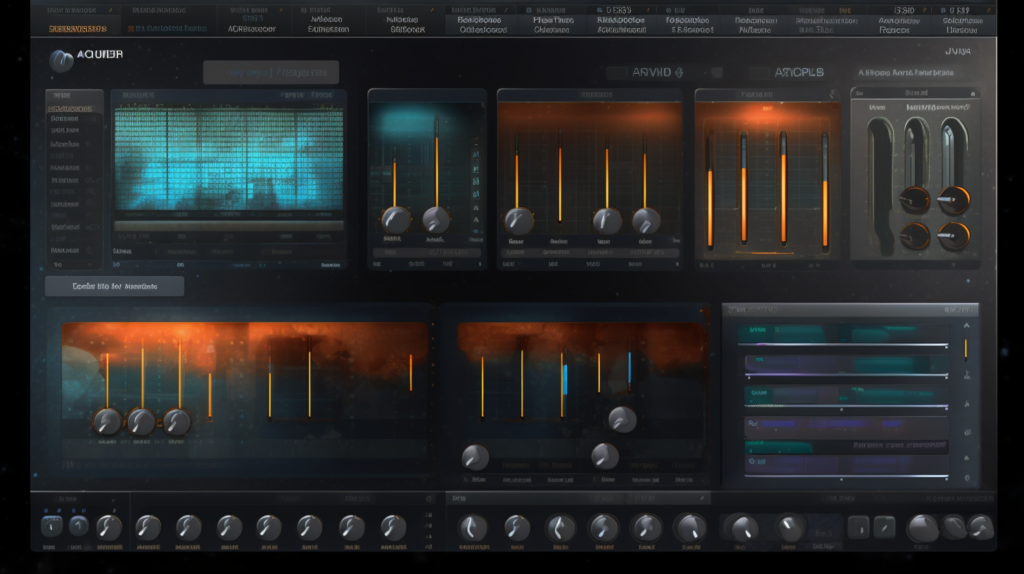
Immersing yourself in the process of making a Travis Scott type beat could well be one of the most engaging and rewarding experiences you can have in the realm of music production. Travis Scott’s distinct sound design is an amalgamation of ambient synths, heavy bass, and punchy, off-kilter drums—a sonic recipe that has defined a generation of hip hop beats. Let’s delve into how you can harness these elements in your music production.
Setting the Stage for Your Beat: A Deeper Dive
As we embark on the journey to create a Travis Scott type beat, our first step is to lay the groundwork that will serve as the cornerstone for the entire beat—establishing the right tone and atmosphere. To evoke a Travis Scott type beat feel, you must venture into a soundscape that’s often dark and somber, imbued with an intoxicatingly eerie vibe.
Establishing the Mood with the Right Scale
As you fire up your music production software, your first order of business is selecting the correct scale or mode. Travis Scott’s music heavily leans on minor scales, known for their melancholic and somewhat gloomy aura. These scales can set a darker and more introspective mood compared to their major counterparts.
For instance, you might want to experiment with the D minor scale. If you’re using a MIDI keyboard, try playing the D minor chord (D, F, A), then venture out to other chords in the scale, such as A minor (A, C, E) or Bb Major (Bb, D, F), maintaining a slow and deliberate pace to set a somber mood.
However, minor scales are just the tip of the iceberg. Venturing into exotic modes like the Phrygian or Locrian opens up a realm of intriguing sonic possibilities. The Phrygian mode, for example, is notorious for its flatted second, creating a sense of unease and tension that complements the Travis Scott type beat aesthetic perfectly. Experiment with E Phrygian (E, F, G, A, B, C, D) for a start, and feel how it immediately sets a darker, more brooding atmosphere.
Harnessing the Power of Synthesis
Once you’ve got your scales down, the next step is to produce the sounds that will breathe life into your chosen scale. For this, we delve into the world of synthesis, the heart of sound design. The goal is to create ambient sounds and resonant tones that echo throughout the track, filling the listener’s space with their rich and enveloping sound.
To create these sounds, you need powerful synthesizers at your disposal. Tools like Serum (free presets here !), Massive, or Omnisphere are renowned in the music production industry for their versatility and the immense sound design possibilities they offer. For instance, consider using Serum to create a dark pad sound. Start with a wavetable like ‘Evol Sweep’ under ‘Digital’ in the oscillator section. Apply some slow LFO modulation to the wavetable position and the filter cutoff to create movement and keep the sound evolving. A generous dose of reverb and delay will also add to the ambiance. I made one for you, that you can download for free here. It will be useful for any trap beat you make, believe me.
On the other hand, Omnisphere offers a vast library of unique and varied sounds that can be an excellent starting point. Try browsing through the ‘Textures Soundscapes’ category, and you might stumble upon a sound like ‘Beautiful Ghost Texture’, which can serve as an impressive foundation for your Travis Scott type beat.
In the pursuit of creating a Travis Scott type beat, remember to take your time to explore and experiment. The real magic happens when you venture out of your comfort zone and push the boundaries of your creativity. The journey may be challenging, but it’s equally rewarding, and at the end of the road, you will have a beat that resonates with the atmospheric and intriguing vibe that makes Travis Scott’s music so compelling.
Bass-Heavy Foundations: The Bedrock of a Travis Scott Type Beat
The heartbeat of a Travis Scott type beat lies in its thunderous, bass-heavy foundation. The genre’s backbone is built on a steady rhythm of deep, pulsating 808s that provide a solid base for the other elements to weave in and out of. Here, we’ll dig deeper into how to construct a robust low-end that packs a punch.
Sculpting the 808s
When you’re crafting a Travis Scott type beat, the 808s aren’t merely an aspect of your rhythm section; they’re a powerful expressive tool in their own right. You’ll want to select an 808 sample that resonates well, with a strong fundamental frequency and enough high-frequency content to allow for further processing.
Take, for example, the 808 samples in the ‘Lex Luger Official Drum Kit’ (free download here !). These samples have a rich low end and just enough distortion to make them stand out. Using a tool like FL Studio’s Fruity Waveshaper, you can shape these samples further, adding harmonics and grit.
Manipulating Your 808s
The real magic of your bass section emerges when you start tweaking the 808s. Slide your notes, pitch-bend them, or experiment with different tunings to keep your listeners on their toes. For instance, you can create an 808 glide in FL Studio by activating the ‘Portamento’ and ‘Mono’ modes in the Channel settings and then overlapping your 808 notes in the Piano Roll.
Layering is another technique to bring out the best in your 808s. By subtly layering a kick sample over your 808s, you give your beat the punch it needs to cut through the mix. Ensure the kick and 808 are in phase, and use sidechain compression if needed to prevent frequency clashes.
Crafting Your Drums: The Rhythmic Engine of Your Beat
When crafting a Travis Scott type beat, one of the most critical elements to consider is the drum patterns. The drums in a Travis Scott beat aren’t just rhythmically inventive; they have a unique feel that’s both off-kilter and intriguing.
Structuring Drum Patterns
Let’s take the hi-hats, for instance. Instead of laying down a simple, predictable pattern, Travis Scott’s music often features hi-hats with various note lengths, velocities, and placements. This gives the rhythm a sense of instability and keeps the listener engaged. Try incorporating 1/8, 1/16, and even 1/32 note variations in your hi-hat patterns.
Innovative Percussions
In addition to the hi-hats, you should also experiment with different snare rolls and unconventional percussion sounds. A signature of a Travis Scott type beat is the creative use of percussive elements. Travis Scott tracks often feature percussive sounds that you wouldn’t typically find in a hip-hop beat. This could be anything from a sampled glass bottle hit to a distorted vocal chop. Don’t be afraid to think outside the box here—the more unique, the better.
Humanizing Your Drums
Finally, it’s worth mentioning the concept of ‘swing’. Adding a bit of swing to your drums can make them sound less robotic and more like a live drummer. You can easily do this in DAW’s like FL Studio or Ableton Live. For example, in FL Studio, you can adjust the swing parameter in the channel rack, giving your beat a more human, less machine-like feel.
As you delve deeper into the world of Travis Scott type beat production, always remember that experimentation is key. The beauty of music production lies in your ability to bend the rules and come up with something that’s truly your own. Whether it’s designing a bass-heavy foundation or crafting intricate drum patterns, the sky’s the limit when it comes to your creative expression.
Creating Ambient Textures: The Soundscape of a Travis Scott Type Beat
When crafting a Travis Scott type beat, setting the right atmospheric conditions is a crucial task. To capture the ambient and resonant sonic qualities prevalent in Travis Scott’s music, you’ll need to infuse your beats with a sense of depth and space. Here, we’ll delve deeper into the sound design techniques that can help you achieve this.
Incorporating Ambient Samples and Textures
One of the defining characteristics of a Travis Scott type beat is its textural richness. This comes from the creative use of ambient samples and textures that introduce complex sonic landscapes into the mix. Think of sounds like a distant thunderclap, rain falling on a tin roof, or even the hum of city traffic at night. These samples, when used creatively, can lend an extra dimension to your beats.
For instance, try layering a sample of a thunderstorm beneath your beat. Apply a high-pass filter to remove any unwanted low-frequency content and adjust the volume so it subtly blends into the mix. The result is a continuously evolving texture that enriches the atmosphere of the beat.
Employing Atmospheric Effects
In addition to using ambient samples, you should also make use of atmospheric effects to create a sense of space and depth. This involves the strategic use of tools like reverb, delay, chorus, and phasing.
Take, for example, the use of reverb. With a tool like Valhalla Room, you can apply a long, dark reverb to your synth pad, transforming it into an atmospheric sound that seems to fill up the entire mix. Try using a decay time of around 4-5 seconds, a mix level of about 20-30%, and a low cut around 200 Hz to prevent muddiness.
Similarly, you can use delay to create a sense of depth. With Soundtoys’ EchoBoy, try applying a dotted eighth note delay to your lead synth. Mix it in subtly, and you’ll find that it adds a pleasant sense of movement and space to your beat.
Mixing and Mastering Your Beat: The Final Polish
The journey to crafting a Travis Scott type beat comes to fruition in the final stages of mixing and mastering. This is where you bring all the elements together, ensure they coexist harmoniously, and add the final polish to your beat. Let’s dive deeper into this process.
Balancing the Mix
In the mixing phase, your main goal is to achieve a balanced mix. The 808s and kick drum should be dominant but not overpowering. The synths should be wide and ambient but should not muddy the mix. Make use of panning, EQ, and compression to ensure every element has its own space in the mix.
For instance, try panning your hi-hats slightly to the right and your snare slightly to the left to create a sense of width. Use a high-pass filter on your synths and lead elements to leave space for the 808 and kick drum.
The Final Master
Once you’ve achieved a balanced mix, it’s time to move on to mastering. Using a mastering suite like iZotope’s Ozone can give your beat the final polish it needs. Start with the ‘Hip Hop’ preset and tweak from there. Use the Maximizer to achieve a competitive loudness level, but be careful not to overdo it and cause distortion.
The key to mastering a Travis Scott type beat is to maintain its unique dynamic and textural characteristics. It should be loud and clear, but it should also retain the atmospheric and immersive qualities that make this type of beat so unique.
Creating a Travis Scott type beat is as much an art as it is a science. As you navigate your way through the world of sound design, mixing, and mastering, remember that experimentation and creativity are your best allies. Don’t be afraid to push the boundaries and create something truly unique. Your journey in the world of music production is a personal one, and the more you invest in it, the more rewarding it will become.
Producer’s Cheat Sheet
| Section | Key Elements | Recommended Tools |
|---|---|---|
| Setting the Stage | Dark Atmosphere, Minor Scales | Serum, Massive, Omnisphere |
| Bass | Heavy 808s, Distortion, Slides | Fruity Limiter, CamelCrusher |
| Drums | Punchy, Off-Kilter, Swing | FL Studio, Ableton Live |
| Ambient Textures | Reverb, Delay, Chorus | Valhalla Room, EchoBoy |
| Mixing and Mastering | Balanced Mix, Wide Synths, Dominant Bass | iZotope Ozone, FabFilter |
Unleashing your inner artist by creating a Travis Scott type beat can be an exciting journey. The key lies in understanding the key elements that define this style and incorporating them into your music production process. So put on your producer’s hat and let’s start making some beats!





